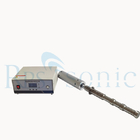
loading
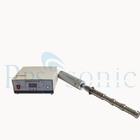



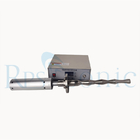

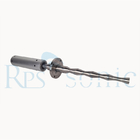

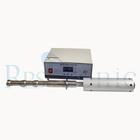

| Availability: | |
|---|---|
| Quantity: | |
| Place of Origin | China |
|---|---|
| Brand Name | Rps-sonic |
| Certification | CE |
| Model Number | RPS-LP20 |
| Minimum Order Quantity | 1pcs |
| Price | negotiable |
| Packaging Details | CARTON |
| Delivery Time | 1DAYS |
| Payment Terms | T/T |
| Supply Ability | 200PCS/MONTH |
20Khz Ultrasonic vibrator for Ultrasonic defoaming equipment on Dish soap
Parameter
| Model | SONO20-1000 | SONO20-2000 | SONO15-3000 | SONO20-3000 |
| Frequency | 20±0.5 KHz | 20±0.5 KHz | 15±0.5 KHz | 20±0.5 KHz |
| Power | 1000 W | 2000 W | 3000 W | 3000 W |
| Voltage | 220/110V | 220/110V | 220/110V | 220/110V |
| Temperature | 300 ℃ | 300 ℃ | 300 ℃ | 300 ℃ |
| Pressure | 35 MPa | 35 MPa | 35 MPa | 35 MPa |
| Intensity of sound | 20 W/cm² | 40 W/cm² | 60 W/cm² | 60 W/cm² |
| Max Capacity | 10 L/Min | 15 L/Min | 20 L/Min | 20 L/Min |
Description
Ultrasound has a wide range of applications. As waves, there are ultrasonic detection technology and measurement technology; applications that convert waves into energy include ultrasound
Wave atomization, ultrasonic cleaning, ultrasonic welding, ultrasonic grinding, ultrasonic cutting, etc. Ultrasonic defoaming is just one of the applications.
Ultrasonic defoaming means that the ultrasonic vibration propagates into the liquid, which will produce cavitation in the liquid. Due to the cavitation, impact will be produced.
In order to make the gas dissolved in the liquid crush and break away. The effect of ultrasound for a period of time can completely remove the gas bubbles in the liquid.
In front of the sonotrode the ultrasound technology generates a phenomenon of acoustic wind without causing any acoustic overpressure : the focusing of the acoustic waves generated by the sonotrode causes a pressure field to spring up at a few cm distance from it, enough to explode the foam bubbles created during the filling operation.
Industrial processes have traditionally control foam through mechanical devices, decreasing tank temperature or adding chemical additives. However, these procedures have the following limitations:
Decreased performance.
Quality problems.
Product losses due to waste.
Microbial contamination.
Production delays and stops.
Obstruction of channels and valves.
Flooding of air filters.
However, high power ultrasonic defoaming systems have proven to be very effective using high power ultrasounds to disperse and control the foam. The creation of an ultrasonic static wave in the air generates nodes and anti-nodes.
The nodes attract matter and so the foam bubbles which implode as a result of the compression forces generated.
Increases fill level and reduces product losses
Increases production capacity and performance
Simplified and reduced maintenance (e.g. no moving parts and readily sterilisable)
Decreases container/packaging rejection rates
No airflow interferes with plant controlled environment
Easily installed in manufacturing lines and no interference with manufacturing process
Reduces the use of anti-foam chemical additives
Improves food security with a lower microbiological risks from leaks
Reduction of defoaming heating/cooling, and its related energy costs
APPLICATION IN PACKAGING LINES
Foam Reduction Technology for Bottling & Canning Line Operations In The Beer Industry Delivering
Foam Reduction Technology for Beverage Bottle & CAN Filling Operations
Foam Reduction Technology for Dairy Bottle & CAN Filling Operations
Cleaning Chemicals Foam Compression Technology
20Khz Ultrasonic vibrator for Ultrasonic defoaming equipment on Dish soap
Parameter
| Model | SONO20-1000 | SONO20-2000 | SONO15-3000 | SONO20-3000 |
| Frequency | 20±0.5 KHz | 20±0.5 KHz | 15±0.5 KHz | 20±0.5 KHz |
| Power | 1000 W | 2000 W | 3000 W | 3000 W |
| Voltage | 220/110V | 220/110V | 220/110V | 220/110V |
| Temperature | 300 ℃ | 300 ℃ | 300 ℃ | 300 ℃ |
| Pressure | 35 MPa | 35 MPa | 35 MPa | 35 MPa |
| Intensity of sound | 20 W/cm² | 40 W/cm² | 60 W/cm² | 60 W/cm² |
| Max Capacity | 10 L/Min | 15 L/Min | 20 L/Min | 20 L/Min |
Description
Ultrasound has a wide range of applications. As waves, there are ultrasonic detection technology and measurement technology; applications that convert waves into energy include ultrasound
Wave atomization, ultrasonic cleaning, ultrasonic welding, ultrasonic grinding, ultrasonic cutting, etc. Ultrasonic defoaming is just one of the applications.
Ultrasonic defoaming means that the ultrasonic vibration propagates into the liquid, which will produce cavitation in the liquid. Due to the cavitation, impact will be produced.
In order to make the gas dissolved in the liquid crush and break away. The effect of ultrasound for a period of time can completely remove the gas bubbles in the liquid.
In front of the sonotrode the ultrasound technology generates a phenomenon of acoustic wind without causing any acoustic overpressure : the focusing of the acoustic waves generated by the sonotrode causes a pressure field to spring up at a few cm distance from it, enough to explode the foam bubbles created during the filling operation.
Industrial processes have traditionally control foam through mechanical devices, decreasing tank temperature or adding chemical additives. However, these procedures have the following limitations:
Decreased performance.
Quality problems.
Product losses due to waste.
Microbial contamination.
Production delays and stops.
Obstruction of channels and valves.
Flooding of air filters.
However, high power ultrasonic defoaming systems have proven to be very effective using high power ultrasounds to disperse and control the foam. The creation of an ultrasonic static wave in the air generates nodes and anti-nodes.
The nodes attract matter and so the foam bubbles which implode as a result of the compression forces generated.
Increases fill level and reduces product losses
Increases production capacity and performance
Simplified and reduced maintenance (e.g. no moving parts and readily sterilisable)
Decreases container/packaging rejection rates
No airflow interferes with plant controlled environment
Easily installed in manufacturing lines and no interference with manufacturing process
Reduces the use of anti-foam chemical additives
Improves food security with a lower microbiological risks from leaks
Reduction of defoaming heating/cooling, and its related energy costs
APPLICATION IN PACKAGING LINES
Foam Reduction Technology for Bottling & Canning Line Operations In The Beer Industry Delivering
Foam Reduction Technology for Beverage Bottle & CAN Filling Operations
Foam Reduction Technology for Dairy Bottle & CAN Filling Operations
Cleaning Chemicals Foam Compression Technology








Ultrasonic Welding Equipment Ultrasonic Welding Transducer Ultrasonic Welding Converter Ultrasonic Liquid Processor Ultrasonic Cutting Equipment Ultrasonic Spray Nozzles Ultrasonic Power Supply Ultrasonic Soldering Equipment Ultrasonic Welding Horn Ultrasonic Assisted Machining Ultrasonic Testing Equipment